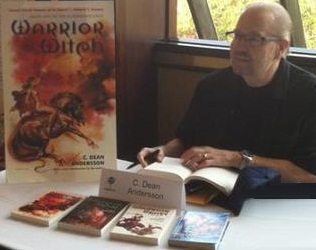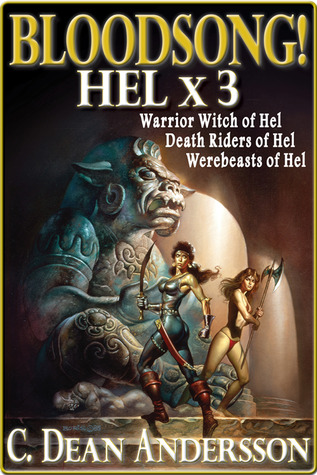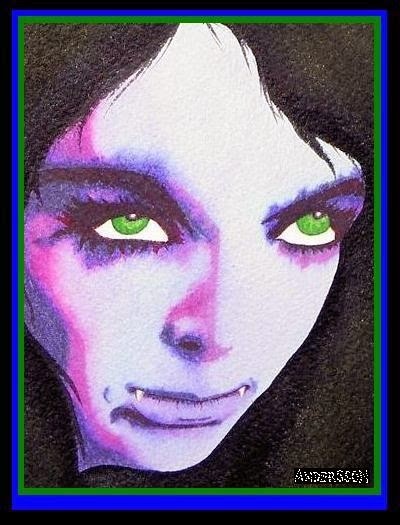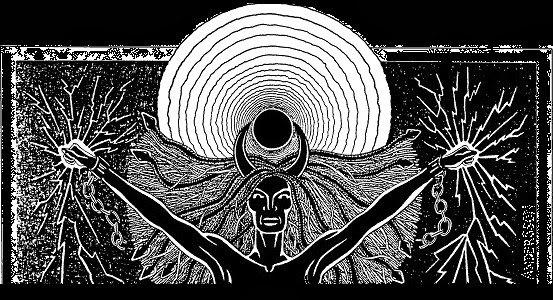C. Dean Andersson Tribute Interview and Tour Guide of Hel: Bloodsong and Freedom!
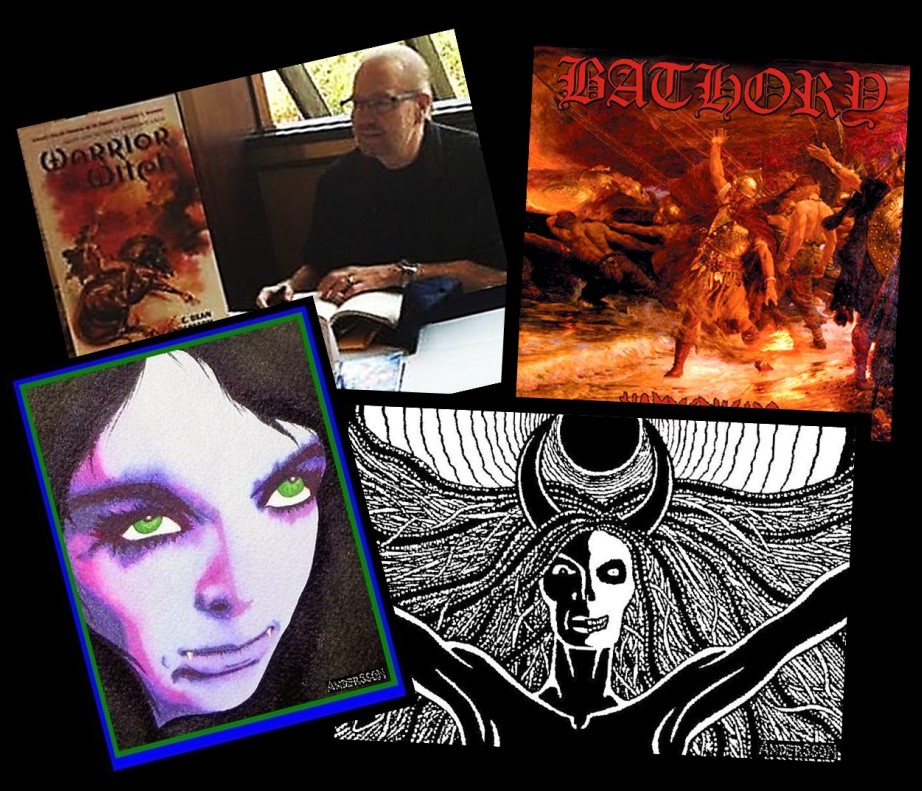
…And on the day two hundred
There it stood white to the sky
The house of the God of the cross
Big enough to take two dragon ships inside
All of Asa bay did watch
The wonder raise to the sky
Now must the God of the cross be pleased satisfied
Just outside the circle of the crowd
One old man did stand
He looked across the waters
And blotted the sun out of his eyes with one hand
And his old eyes could almost see
The dragon ships set sail
His old ears could almost hear
Men of great numbers call out Oden’s hail
And though he did know alreadyThough he turned face towards sky
[partial lyrics to “One Rode to Asa Bay” by Bathory]
Whispered silent words forgotten
Spoken only way up high
Now this house of a foreign God does stand
Now must they leave us alone
Still he heard from somewhere in the woods
Old crow of wisdom say…
people of Asa land, it’s only just begun…
July 5th, 2021 marked the passing of C. Dean Andersson (a.k.a, Asa Drake). Christopher Fulbright (author, a journalist turned technical writer, and owner/webmaster of Realms of Night) posted a moving tribute this month online. Mr. Fulbright is also credited with one of the most popular pictures of Andersson (inset). Andersson had his fame with both horror fans and the fantasy crowd for his Sword & Sorcery heroine Bloodsong. This post honors him by combining a review of his Bloodsong Saga (a.k.a. Hel Series) with a reposting of a 2014 interview regarding his creative process (with 3x illustrations he made to complement his written art, shared below).
Before jumping in, let us highlight Andersson’s somewhat recent posts on the esteemed DMR Book blog. In early 2020 he reviewed the publication history of the Bloodsong trilogy in the article Heavy Metal Sword and Sorcery in which he delighted in the label “Heavy Metal”. By the way, he was still writing, promising both a fourth Bloodsong book called Valkyries of Hel and a second book for the I Am Dracula series called I am the Witch (the status of these are unclear). Speaking of Heavy Metal, in 2019 Andersson explained his relationship with an actual heavy metal artist Quorthon (of the group Bathory, named after the famed vampiress) who had passed away in ~2004. A portion of the lyrics to “One Rode to Asa Bay”, a song made in Andersson’s honor in the Hammerheart album, graces the opening of this post. It is not much of a stretch to imagine standing on the shoreline saluting Andersson as his funerary ship sails away from Asa Bay.
Topics Herein (Quick Links):
- C. Dean Andersson’s Bio
- Hel x 3 Review and Bloodsong Series Tour Guide
- Grotesque Beauty: author interview including horrific muses and “x 3” illustrations
C. Dean Andersson (Author’s Website Bio)
C. Dean Andersson writes fantasy and horror. He received a Horror Writers Association finalist award for “The Death Wagon Rolls On By.” His novels have been published by HarperCollins, Hachette, and Kensington. His explorations include Dracula’s passions (I am Dracula), Frankenstein’s secrets (I am Frankentein), the vigilante Witch Medea’s pursuit of child killers (Fiend), the Blood Countess Bathory’s sadism, (Raw Pain Max), and Vikings fighting Evil (HEL x 3). Upcoming releases include Valkyries of Hel (Book 4 of the Hel Series) and I am the Witch (Book 2 of the I am Dracula series).
HEL x 3 Review and Bloodsong Series Tour Guide
An Entertaining Gateway to Hell, and Toward Darker Fiction
The three books combined in Bloodsong! — Hel X 3 were written within ~1.5 yrs (1985-86). C. Dean Andersson (aka Asa Drake) was motivated to make a fun horror series on quick timing. The result was easily digestible horror/fantasy, all rooted in Viking lore. The trilogy includes 1) Warrior Witch of Hell; 2) Death Riders of Hell; and 3) Werebeasts of Hel.
The concepts and setting really carry the story: a reanimated mother is out to save her unborn daughter from the Goddess Hel. This more than compensates for the dialogue which relies heavily on characters broadcasting their intentions. Its simplistic tone and fast pace are appropriate for young-adult novels, but its abundance of mature scenes makes it more suitable for adults (there are many heroines who continually find themselves stripped naked, chained, and tortured). This is highly recommended for epic/high fantasy readers looking for darker fiction. It would work well as a “gateway drug” for those introduced to fantasy via Tolkien, but are now looking for grittier fare.
Bloodsong and Freedom!
The conflict centers on the female warrior Bloodsong who is pitted against Hel Queen of Darkness, Death Goddess. It begins with Bloodsong coming back from Hel’s domain, resurrected and sworn to serve the Goddess. Hel is holding Bloodsong’s daughter, hostage (she had died in Bloodsong’s womb, but was raised in Helheim). The conflict over freedom/domination is persistent and explicitly echoed in the protagonist’s war cry & call to action “Bloodsong and Freedom!” The subsequent books fill in many details about Bloodsong’s husband and her son, who had died during the same raid as she; they are, of course, plagued past their natural deaths.
Fun Horror
The variety and abundance of undead creatures make this most fun, and their titles speak to their coolness: Flesh Demons (skeletons who steal skin), Skull Slaves (humans possessed by ghosts), Death Riders (undead warriors mounted on skeletal Hel-Horses who ride the wind), Corpse Beasts (humanoids who eat their kill), Hel-Witch (sorceress who draw upon Her powers), etc. There are of course Viking inspired monsters (i.e. Frost Giants, Invisible Dwarves), but the series is really about Hel’s incarnations, as the three titles communicate, so expect lots of necromancy.
New vs. Old
The 2013 HEL x 3 eBook release has a lengthened first book (in the omnibus, the first book Warrior Witch from Hel has 24 chapters versus the original 18). The remaining books have the same number of chapters, but their content is altered to accommodate some character development, mostly regarding the secondary character Jalna. The additions are fine, but the paperback originals are just as enjoyable. The original HEL x 3 eBook release had one production error (Book 3 Chapter 18 should have been “Unsevered bonds” but it was instead a repeat of Book 2 Chapter 18 “Visitors”; I worked with Andersson to contact the publisher, and I assume it was fixed).
The illustrations for the paperbacks and eBook are from Boris Vallejo. They are incredible and accurately portray the characters and books’ tone:
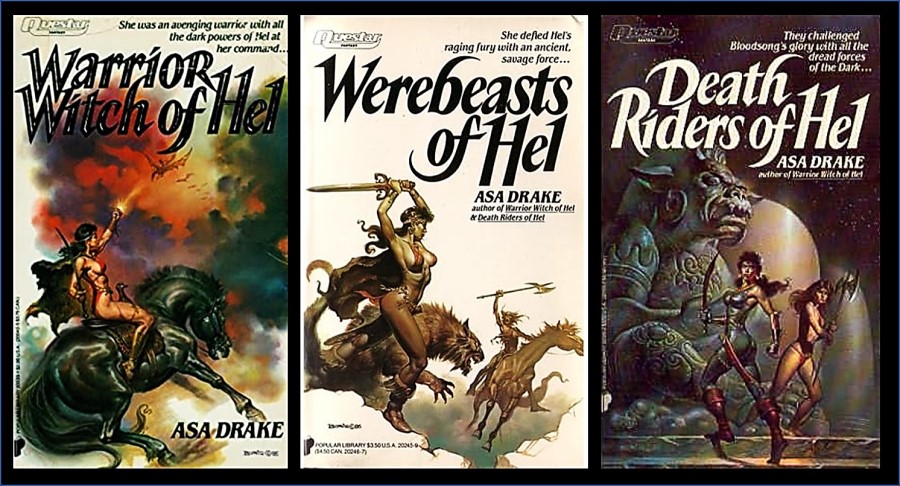
More Bloodsong Adventures
????: Book #4 of the Bloodsong Saga was in progress in 2014, called Valkyries of Hel. Its status is unclear.
2021: A new Bloodsong story was in the works for Robert M. Price’ Flashing Swords 7 Anthology
2006: For the World Fantasy Convention in Austin, Texas, there was an R. E. Howard centenary tribute anthology called Cross Plains Universe – Texans Celebrate Robert E. Howard. Therein there is a fun, Bloodsong short “Slim and Swede and the Damned Dead Horse.”
1996: Eternal Champion cross-over: In the Pawn of Chaos: Tales of the Eternal Champion anthology, Bloodsong interacts with Michael Moorcock’s eternal champion (the Urlik Skarsol incarnation) in the short story: “The Warskull of Hel” (which was the title for the first book in the trilogy according to the author). This continues the saga in a solid way, even if a short story.
Interview with C. Dean Andersson (2014)
It is not intuitive to seek beauty in art deemed grotesque, but most authors who produce horror/fantasy actually are usually (a) serious about their craft, and (b) driven my strange muses. This continues the interviews of weird/speculative fiction authors on the themes of Art & Beauty in Fiction (these began in 2014 and moved into Black Gate under the Weird Beauty tag in late 2018). The below interview was highlighted on the author’s website along with one from Terry Ervin in 2013. Note that GW Thomas also published a splendid interview called The Kings of the Night.
Grotesque Beauty
SEL: You seem fascinated with the Goddess Hel. The HEL x 3 trilogy is titled and inspired after her after all (with a fourth Valkyries of Hel in progress), and you received a Bram Stoker Award finalist ranking for your story about a modern encounter with the Goddess Hel, “The Death Wagon Rolls on By.” Hel has a wonderful character design, being half-living-beauty / half-corpse; she explicitly represents the paradox of attractive horror. In the anthology Pawn of Chaos: Tales of the Eternal Champion, your short story “The Warskull of Hel” has Bloodsong working with Michael Moorcock’s eternal champion (the Urlik Skarsol incarnation); Urlik discovers Hel and suggests that her corpse-side may be beautiful:
“So, you think me beautiful, do you, Urlik Skarsol?” The woman on the throne laughed, a sound like a raven’s call. “Yes, your thoughts are known to me, and that this image of beauty is the most dear to you of any in existence. But you have not seen my other side.” She pulled back her hair and revealed the half-face of a rotting corpse. Her laughter again echoed from icy walls.
Urlik quickly concealed his shock and said , “Someone in horrible pain might think Your face of Death most beautiful.”
Your own fiction is “horrific” but you share it nonetheless, and invite others to share in the grotesque.
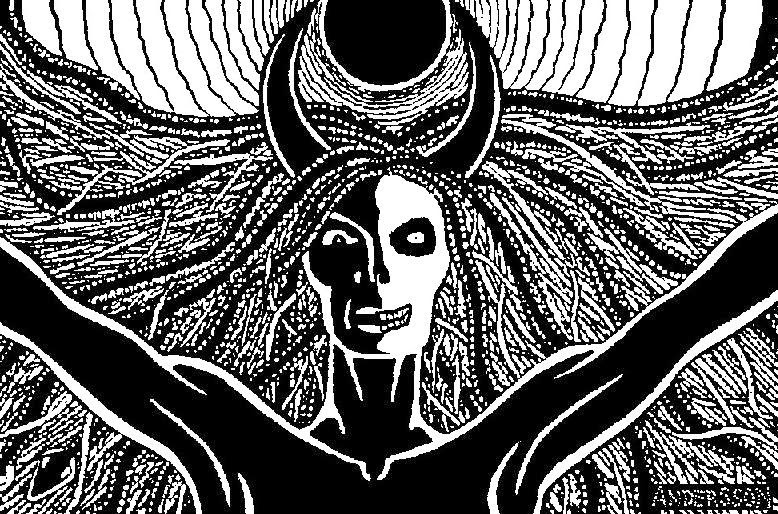
How do You Make the Corpse-side of Hel Appealing?
CDA: It is beyond my power to do so, without audience participation. If the Thanatos in Eros-Thanatos triggers your libido and stimulates fantasies darker than most can stand, kissing the corpse-side of Hel’s face may be your cup of tea. But whatever affects you strongest, the mythic power of Hel’s image comes from the emotional tension generated by its Ying-Yang juxtaposition of Life and Death.
Hel, whichever side you prefer, can be a kind of visual Norse aphrodisiac. Her dead side reminds you, at least on a subconscious level, to beat the genetic clock and reproduce before it’s too late. Of course in our too-clever-for-our-own-good human ways, sexual gratification is often consciously unrelated to reproduction. Hel’s appearance also inspires an appreciation of our current life because she reminds us of our future death. She holds, in addition, in her life qualities, the promise of rebirth to new life. Some Norse believed in reincarnation within family lines. If that is your belief, Hel’s death side is a door your spirit must pass through to get to your future.
I probably need to point out, for the Norse challenged, Hel is not Death. She takes care of the Dead. But her realm is the Norse Underworld where the environment itself was believed to be unpleasant, dark and cold, like a grave. In fact, one suggested origin for her name is that it simply meant “to cover over,” as in a burial.
Hel is a goddess whose concept probably predates the Norse Myths. How old is the awareness of an eventual, personal, physical extinction? In the myths, she is portrayed as a special child disfigured at birth but loved by her mother, a Jotun, giantess — Neanderthal? — whom the myths call Angrboda, Anguish-Boding. The gods kidnapped Hel and her brothers, Fenris the Chaos Wolf and Jormungandr the World Serpent — two other ancient power symbols — from their mother because Odin and company feared their potential roles in Ragnerok, where gods are predicted to die.
At Ragnerok, Fenris is to kill Odin. Jormungandr is to kill Thor. And Hel sails to battle from the Underworld with an army of the Dead in Naglfari, a ship made from dead men’s nails. It is said the Norse kept their fingernails short to delay Naglfari’s completion. Fenris was chained on an Island. Jormungandr was thrown into the ocean. But Hel was exiled to the Underworld where, still possessing power in all the Nine Worlds, she established a refuge for souls unchosen by other deities. In HEL X 3, I named her the Goddess of the Forgotten Dead.
Drawing vs. Writing
SEL: Depicting a character in words requires a different creative process than drawing. For The Brutarian #52, Fall 2008, you tapped into your fine arts training and depicted a dark goddess to complement an interview (VAMPIRES, WITCHES AND WARRIOR – OH MY! by Michael McCarty) and a short story featuring the Queen of the Sumerian Underworld, Ereshkgal (MAMA STRANGELOVE’S REMEDIES FOR AFTERLIFE DISORDERS OR, HOW I LEARNED TO STOP WORRYING AND LOVE MOTHER DEATH). I was surprised to learn that you had a drawing side to you, and even sold illustrations at science fiction conventions.
Did Your Fine Arts Education/Creative-Process Inform Your Fiction? Do You Still Create Illustrations, Perhaps as Part of the Creative Writing Process?
I doodled spaceships and robots all over the margins of my first-grade papers. The teacher, Goddess bless her, encouraged me to keep at it. I had no formal art training until college, where I abandoned the music major I had planned at the last minute and, on an unplanned urge, switched to the art registration line instead—try explaining that one to parents who had scraped and saved to help you afford college.
But somewhere in high school I started writing stories. After college, I spent four years in the Air Force then worked in art before I started being serious about my writing and trying to sell it. Images I visualized and drew or painted have been used in my books. The “Portrait of a Vampire” here (Image #2) is a watercolor drawing that I created years before I wrote about Tzigane, Dracula’s mate. Tzigane undergoes rigorous training and devotes her life and Undeath to becoming a powerful Vampire-Witch, with a mission to convince Dracula of a destiny that requires he voluntarily allow her to initiate him into Vampirehood.
My watercolor is a drawing overlaid with washes using vivid “Dr. Martin’s” dyes. In retrospect, it has much of my future Tzigane in it, or vice versa. It is based on a still from The Ghost, showing the star, Barbara Steele. Her extraordinary eyes and face and acting is an inspiration to many artists, writers, poets and dark fantasy aficionados in general (see Paghat’s review of Barbara Steele work.)
At one time, a number of art pieces I created had inspiring visions of Steele as their theme. Then, at an SF convention art show in L.A., the late Forrest J. Ackerman, editor of Famous Monsters of Filmland and, of course, a childhood hero, bought one, “for a Barbara Steele collector in Belgium,” was all he would say. That collector’s name remains a mystery to this day, but I hope he or she enjoyed the art.
Another example, not shown here, because I couldn’t find the original to scan, is a drawing that was my version of the time-honored “Death and the Maiden” theme. Edvard Munch’s famous drawing of “Death and the Maiden” is an interesting example. But my version was placed in a dungeon and later used in the second Bloodsong book, where the character named Huld is captured by the villain, Thokk, chained in Thokk’s dungeon, and tormented by a living skeleton.
Traditional and modern “Death and the Maiden” images are analogous to Hel’s image, by the way. A young woman is a potential source of new life, while the contrast of a figure representing Death twists the emotions into a stimulating brew. And it does not have to be a Grim Reaper reminding you of Death. A place of Death like a tomb haunted by spiders or a place that threatens horror and death like a rat-infested Inquisitor’s dungeon can serve just as well.
In general, I don’t see any difference in the basic inner creative process when creating visual art or creating stories. I see the scenes I create in books as if I had drawn them first, whether or not I actually have. I write from one scene to the next. The scenes I see could be illustrated if I had the time. One day I hope to illustrate a book or books I write or have written. That, too, would be fun.
Illustrations
The full-faced drawing is an ancient and monstrously powerful “Gorgon Goddess” (Image#3) who has broken her chains and is rampaging against those who tried to destroy her through prejudiced patriarchal propaganda and fear-centric “new religions.” She’s loose! Watch out! Be afraid! Unless you’re her friend.
The half skull-faced “Portrait of Hel” (Image #1) was later adapted from the “Gorgon Goddess” for use as an Internet avatar. Portrait of Hel shows the living half of her face as black and featureless, in total shadow, and the dead half of Her face as skeletal white and skullish.
Can You Comment on Your Own Attraction Toward Repulsive/Terrifying Things?
I did not at first go looking for scary things as a kid, but if something scared me enough, it ran the risk of getting chased down and tackled. A good example is my first Dracula movie. For some reason, the concept of a corpse sneaking into my house to suck my blood while I was sleeping gave me nightmares. The idea threatened me. I needed to know more about it.
I found and read Stoker’s Dracula, which also scared me,then a disturbing non-fiction book about worldwide vampire beliefs, Montague Summers’ The Vampire, His Kith and Kin. Vampires, it turned out, were everywhere, and always had been. Nevertheless, the next Halloween, I went trick-or-treating as Dracula. I was not too comfortable doing it. But it gave me a feeling of power and pride. I thought, if worse things than a Vampire showed up, a kid who dared to play Dracula could probably survive them. And because I wanted to find those worse things before they found me, I started looking for scary stuff in books, magazines, and movies.
Looking back, instead of being attracted to repulsive and terrifying things, I was seeking them out and studying them, to gain power over them. I’ve had many people say horror writers seem unusually well adjusted. Maybe it’s because we explore our fears in our stories. More likely, insert ominous laugh, it’s a trick. On ourselves.
Should Horror be “Fun” or “Monstrous”?
In the 2008 interview, you mentioned
I find [horror] fun, for starters, and these days, I don’t want to waste time on fiction writing that is not fun…If I need an artsy excuse for my motivation, I can quote Tristan Tzara’s 1918 Dada Manifesto: “Art should be a monster that casts servile minds into terror.
Should horror be “fun” or “monstrous”?
If I have fun creating something, you stand a better chance of having fun experiencing it. I don’t enjoy reading a depressing, no hope in sight horror story, no matter how important and realistic such stories are sometimes judged to be. So, I do not have creating stories like that as a goal. Having horrible things happen in horror stories is required, and even likable characters may not have happy endings. But someone in my stories has to fight back and hope to win, which in my experience is far more realistic than give-up-and-die tales. People do not accept defeat easily.
Most humans are heroic, often in quiet ways. They fight epic interior wars, invisible on the outside, unguessed by people who pass them in the street and often by people who live and work with them. They resist overwhelming odds, circumstances, sickness, and other people or things that threaten them and their families’ lives, hopes, and dreams. By placing characters in hyper-extreme situations in my stories, I have shown their discovery of strengths they had not known they possessed. I have had readers say such characters are inspirations. I know the same has been true for me, reading other people’s books.
The character I created in Torture Tomb named Bernice, an ordinary young woman with ordinary hopes and dreams, is mercilessly tormented beyond anything she could have imagined surviving. But not only does she survive, though crippled by her injuries she returns, wheelchair-bound, in Fiend to fight for and help others.
The slave woman named Jalna in Hel X 3 survives horrible injuries, too, and becomes one of Bloodsong’s fiercest warriors. Bloodsong herself survives impossible odds and repeated tortures as a slave before leading a rebellion. She even finds a way to return from the dead to save her daughter and fight on. Everyone breathing is a survivor. And almost everyone, sooner or later, has to fight to stay alive. When backed into a corner, in my horror stories as in life, most people, no matter how docile they might at first seem, will fight back and sometimes win. They grit their teeth and turn into Conan the Barbarian if pushed far enough. So, watch out, power mongers, tyrants, and bullies. You have been warned.
Dark Muses: Have You Been Trying to Put a Pretty Face on Your Fears?
It seems that you are not only trying to entertain “servile” minds, but are also driven to realize your own fears. In your recent interview with Terry Ervin (link) you revealed that you had a phantom muse: an “Old Woman in Black.” Please expand how this female haunt has motivated your writing. For instance, Raw Pain Max , Torture Tomb, and your The Bloodsong Saga (HEL x 3) all feature strong woman as protagonists, as does every other book or story you have created. Are these manifestations of your dark muse? Have you been trying to put a pretty face on your fears? Is it therapeutic to give your dark muse substance in art (i.e. are fears heightened or alleviated)?
My strong female characters are probably inspired in part by the power I sensed in my Dark Muse, whatever she was, when I was afraid of her as a kid. Women I have known well in life, grandmother, mother, childhood best friend, and spouse, are definitely also responsible. As the old saying goes, you write what you know. The women warriors in my Bloodsong books are obvious examples. But all my books have strong women in them. And all have examples of my shape-shifting Dark Muse.
Raw Pain Max features a female bodybuilder named Trudy who performs as a crack-that-whip dominatrix in live sex stage shows. Trudy is also, she is horrified to discover, the reincarnation of the historical Hungarian Blood Countess, Elizabeth Bathory, the famous mass murderess who tortured young women and bathed in their blood. My Countess was haunted by a powerful Dark Muse, which she called her Ally.
In Torture Tomb, one of the characters is watched over and protected by a supernaturally powerful female haunt he believes is his dead mother. From early childhood, she visited him at night and forced him to learn dark secrets that, though terrifying, gave him power.
The Goddess Hel in HEL x 3 I’ve already described. Her relation to the Old Woman in Black I feared in childhood dreams and apparitions is obvious.
Tzigane in I Am Dracula and Katiasa in I Am Frankenstein are strong characters I loved creating and intend to use again in new books. I’ve already mentioned Bernice in Torture Tomb and Fiend. The novel, Fiend, also has Trudy from Raw Pain Max in it, and Fiend features my version of the immortal Witch and powerful High Priestess of the Goddess Hecate, Medea. She is a strong woman who is also a Dark Muse to others. Bernice and Trudy are inspired by her and follow her.
But to me the question now is, did I see that Old Woman in Black as a kid because of who and what I was and am? Or am I who and what I am because I saw that Old Woman in Black, whoever or whatever she was and is? She might have been one thing or a combination of things. There might have been an actual old woman wearing black at the first. There might have been a ghost of a widow who still visited her old hometown. I’d like to believe that, a lot. Or, there might have been something that had nothing to do with an old woman in widow’s weeds that my mind interpreted wrong.
On the other hand, maybe she was a traditional, ancestral, Scandinavian, guardian female spirit like I‘ve read about in Norse Myths. Could she have been, though, some kind of Jungian Old Crone Goddess-Archetype from the human collective subconscious, like the Greek Hecate or Celtic Morrigan or Summarian Ereshkigal or Babylonian Tiamat or Norse Hel? Most days, I’m quite fond of that explanation. But maybe she was a UFOnaut who repeatedly abducted me for experiments and hid behind an Old Woman’s image that he-she-it-they inserted into my brain. Or was she “just my imagination?”
More likely, she was Cthulhu in disguise, a Lovecraftian Old One from the insanely vast spaces between the stars who picked me to inspire because I’m not really human but a stellar hybrid with sub-dimensional tentacles that touch things which should not be. Yes, that last one is probably the answer. Excuse me while I update my bio. But whatever I experienced and have fun speculating about now, I don’t think I still fear her. I suspect, should she appear and lift that veil, I would see whatever I needed to see or was capable of seeing. And I believe we could have a very interesting conversation.
Dedicated to C. Dean Andersson
S.E. Lindberg is a Managing Editor at Black Gate, regularly interviews authors on the topic of “Beauty & Art in Weird-Fantasy Fiction,” and is the lead moderator of the Goodreads Sword & Sorcery Group. He contributes short stories for Perseid Press’s Heroes in Hell and Heroika series, and independently publishes novels under the banner Dyscrasia Fiction.
